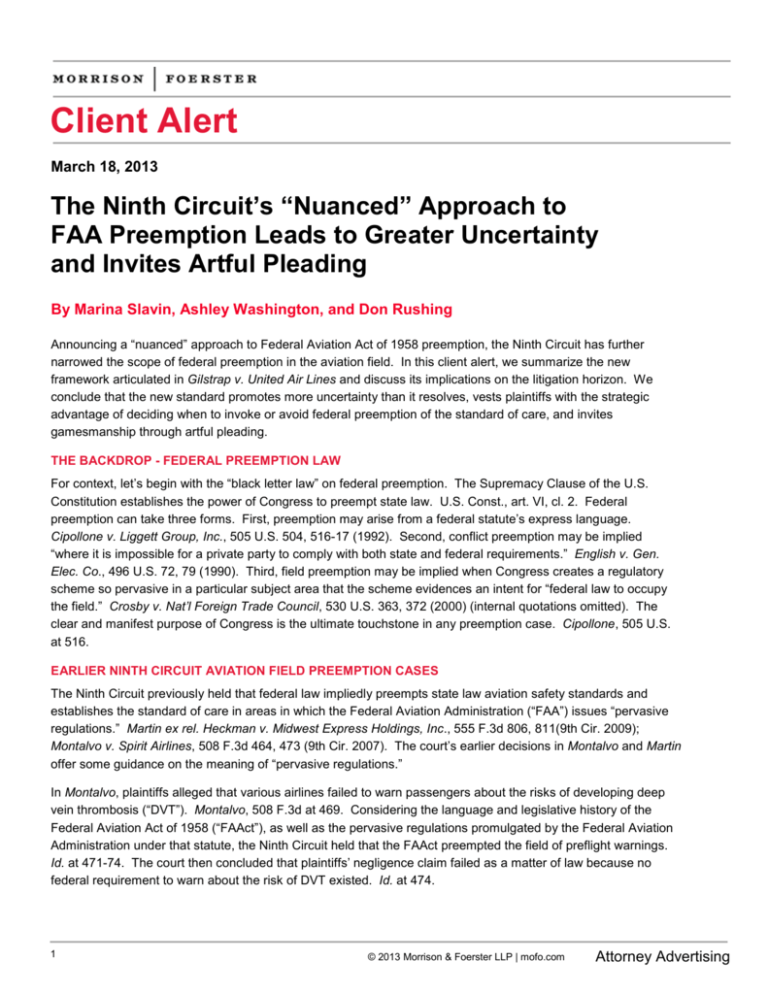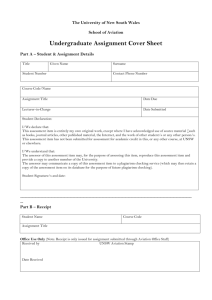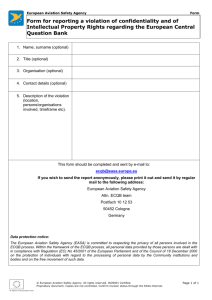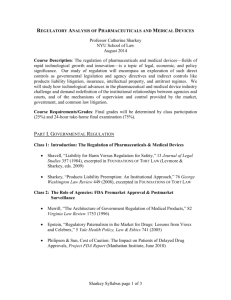The Ninth Circuit's “Nuanced”
advertisement

Client Alert March 18, 2013 The Ninth Circuit’s “Nuanced” Approach to FAA Preemption Leads to Greater Uncertainty and Invites Artful Pleading By Marina Slavin, Ashley Washington, and Don Rushing Announcing a “nuanced” approach to Federal Aviation Act of 1958 preemption, the Ninth Circuit has further narrowed the scope of federal preemption in the aviation field. In this client alert, we summarize the new framework articulated in Gilstrap v. United Air Lines and discuss its implications on the litigation horizon. We conclude that the new standard promotes more uncertainty than it resolves, vests plaintiffs with the strategic advantage of deciding when to invoke or avoid federal preemption of the standard of care, and invites gamesmanship through artful pleading. THE BACKDROP - FEDERAL PREEMPTION LAW For context, let’s begin with the “black letter law” on federal preemption. The Supremacy Clause of the U.S. Constitution establishes the power of Congress to preempt state law. U.S. Const., art. VI, cl. 2. Federal preemption can take three forms. First, preemption may arise from a federal statute’s express language. Cipollone v. Liggett Group, Inc., 505 U.S. 504, 516-17 (1992). Second, conflict preemption may be implied “where it is impossible for a private party to comply with both state and federal requirements.” English v. Gen. Elec. Co., 496 U.S. 72, 79 (1990). Third, field preemption may be implied when Congress creates a regulatory scheme so pervasive in a particular subject area that the scheme evidences an intent for “federal law to occupy the field.” Crosby v. Nat’l Foreign Trade Council, 530 U.S. 363, 372 (2000) (internal quotations omitted). The clear and manifest purpose of Congress is the ultimate touchstone in any preemption case. Cipollone, 505 U.S. at 516. EARLIER NINTH CIRCUIT AVIATION FIELD PREEMPTION CASES The Ninth Circuit previously held that federal law impliedly preempts state law aviation safety standards and establishes the standard of care in areas in which the Federal Aviation Administration (“FAA”) issues “pervasive regulations.” Martin ex rel. Heckman v. Midwest Express Holdings, Inc., 555 F.3d 806, 811(9th Cir. 2009); Montalvo v. Spirit Airlines, 508 F.3d 464, 473 (9th Cir. 2007). The court’s earlier decisions in Montalvo and Martin offer some guidance on the meaning of “pervasive regulations.” In Montalvo, plaintiffs alleged that various airlines failed to warn passengers about the risks of developing deep vein thrombosis (“DVT”). Montalvo, 508 F.3d at 469. Considering the language and legislative history of the Federal Aviation Act of 1958 (“FAAct”), as well as the pervasive regulations promulgated by the Federal Aviation Administration under that statute, the Ninth Circuit held that the FAAct preempted the field of preflight warnings. Id. at 471-74. The court then concluded that plaintiffs’ negligence claim failed as a matter of law because no federal requirement to warn about the risk of DVT existed. Id. at 474. 1 © 2013 Morrison & Foerster LLP | mofo.com Attorney Advertising Client Alert Throughout Montalvo, the Ninth Circuit emphasized that FAA regulations regarding passenger warnings and aviation safety were numerous, “specific,” “detail[ed],” “complete,” “thorough” and “comprehensive[].” Id. at 472474. Montalvo further suggested that the pervasiveness of these regulations evidenced a congressional intent to broadly preempt state law in the field of aviation safety. Id. Two years later, the Ninth Circuit decided Martin, in which it rejected a broad reading of Montalvo and squarely limited the scope of field preemption under the FAAct. Martin, 555 F.3d 806. The plaintiff in Martin alleged that an airplane’s “stairs were defectively designed because they had only one handrail.” Id. at 808. The Ninth Circuit held that state law was preempted by the FAAct only if the specific area covered by plaintiff’s tort claim was the subject of “pervasive” federal regulations. Id. at 811. Applying this standard, Martin held that the FAAct did not preempt plaintiff’s defective stairs claim because “the only [federal] regulation on airstairs is that they can’t be designed in a way that might block the emergency exits” and that Federal Aviation Regulations were otherwise silent on airstair safety issues. Id. at 812. This was in stark contrast to the lengthy, comprehensive, and detailed passenger warning regulations that supported a finding of field preemption in Montalvo. THE GILSTRAP DECISION Last week, the Ninth Circuit further clarified its “nuanced” approach to FAAct field preemption in Gilstrap v. United Air Lines, Inc., No. 11-55271, ___ F.3d ___, 2013 U.S. App. LEXIS 4888 (9th Cir. Mar. 12, 2013). The plaintiff in Gilstrap alleged that she had difficulty walking and that United Air Lines (“United”) failed to provide her with adequate assistance moving through airport terminals. Id. at *2-3. Gilstap sued United, asserting state tort law claims for negligence, breach of common carrier duty, and infliction of emotional distress, among other causes of 1 action. The central question presented in Gilstrap was whether and to what extent the Air Carrier Access Act (“ACAA”)—an amendment to the FAAct addressing an air carrier’s responsibilities to handicapped passengers— preempted plaintiff’s state law tort claims. The Ninth Circuit concluded that the FAAct and its ACAA amendment did not contain an express preemption clause and that plaintiff’s personal injury claims did not conflict with the federal statutory provisions and their implementing regulations. Id. at *18, 36-39. Gilstrap also held that the FAAct and ACAA were not broadly field preemptive of state tort claims and remedies, but could preempt state standards of care if “pervasive federal regulations” had been issued in the specific area covered by the tort claim or state law plaintiff asserted. Id. at *26-28. In evaluating field preemption, Gilstrap further clarified that the “pervasive regulation” analysis must be undertaken in connection with “each theory of liability” asserted by plaintiff. As to Gilstrap’s first theory of liability—that United failed to provide her with adequate assistance—the Ninth Circuit concluded that the ACAA regulations “spell out in detail” when and where air carriers must provide assistance to passengers with disabilities, and by this comprehensive structure and pervasiveness, preempt state laws imposing higher or different duties. Id. at *29-30 (enumerating relevant regulations). But on considering Gilstrap’s separate theory that United was liable for allegedly exhibiting hostility in response to her requests for assistance, the Ninth Circuit explained the ACAA regulations were entirely silent regarding “how airline agents should interact with passengers,” and thus, did not preempt any state law duties. Id. at *31. 1 2 The Ninth Circuit held that Gilstrap’s separate claim under Title III of the Americans with Disabilities Act (“ADA”) was properly dismissed by the trial court because an airport terminal is excluded from the ADA’s covered “places of public accommodation.” Id. at *41-43 (distinguishing an airport terminal from other airport facilities such as restaurants and stores). © 2013 Morrison & Foerster LLP | mofo.com Attorney Advertising Client Alert THE “PERVASIVE REGULATIONS” STANDARD Read together, Montalvo, Midwest, and Gilstrap make clear that the Ninth Circuit’s FAAct field preemption analysis turns on the specificity and comprehensiveness of the federal regulations at issue. Gilstrap, 2013 U.S. App. LEXIS 4888 at *22-23. On one end of the spectrum is Montalvo, where the court readily identified numerous, “specific,” “detail[ed],” “complete,” “thorough” and “comprehensive[]” FAA regulations governing preflight warnings. Montalvo, 508 F.3d at 472-74. Martin represents the other end of this spectrum, where the court concluded that one, “stray regulation . . . was not enough to deem aircraft stairs ‘pervasively regulated.’” Gilstrap, 2013 U.S. App. LEXIS 4888 at *23. Many subsequent cases will fall somewhere on the continuum defined by Montalvo and Martin, and require courts to consider the specificity and completeness of FAAct and ACAA regulations on various subjects. The results of that analysis are difficult to predict, as evidenced most clearly by the ACAA implementing regulations Gilstrap considered. The Gilstrap panel concluded that these regulations were sufficiently “pervasive” and field preemptive on issues of when and where air carriers have a duty to assist disabled passengers. Id. at *29. But the Third Circuit reached a different conclusion in Elassaad v. Independence Air, Inc., when the court held that the ACAA and its implementing regulations did not preempt state law with respect to an air carrier’s duty to assist disabled passengers in deplaning. 613 F.3d 119, 132 (3d Cir. 2010). Elassaad may be explained by the Third Circuit’s conclusion that the ACAA is primarily concerned with ensuring respect and equal treatment for disabled passengers, rather than regulating safety. Id. at 131-32. Nonetheless, Elassaad’s holding is troubling because the ACAA regulates with considerable specificity air carriers’ duties to 2 provide assistance in deplaning. The fact that the Third Circuit did not deem these regulations sufficiently pervasive to preempt a higher or different state standard of care suggests that the “pervasive regulations” inquiry is judicially malleable and results in considerable uncertainty. FURTHER IMPLICATIONS OF GILSTRAP There is no doubt that Gilstrap squarely cabins the reach of FAAct preemption. In particular, Gilstrap makes clear that even where relevant and pervasive federal regulations are present, the scope of field preemption extends only to the standard of care; all other aspects of plaintiffs’ claims and remedies are dictated by state law. The result is that plaintiffs can invoke various state remedies and causes of action for a violation of FAA or ACAA regulations. Unless defendants can establish diversity or plaintiffs plead an alternate basis for federal question jurisdiction, such claims—and the federally dictated standard of care implicit therein—will generally be adjudicated in state court. Plaintiffs will also have considerable discretion in deciding when to invoke or avoid FAAct preemption. Gilstrap makes clear that the field preemption inquiry turns on the theories of liability plead by plaintiffs. Therefore, even if an air carrier indisputably complies with the federal standard of care, plaintiffs can avoid dismissal by asserting 2 3 See 14 C.F.R. § 382.95 (detailing obligations to provide deplaning assistance, including provision of assistance through use of lifts or ramps where level-entry loading bridges are not available); id. § 382.99 (requiring air carriers to negotiate with airport operators to ensure provision for lifts where level-entry loading bridges are not available for deplaning); id. § 382.101 (requiring air carriers to provide deplaning assistance when entry-level boarding and deplaning assistance not required); id. § 382.141 (requiring air carriers to train personnel regarding the use of deplaning assistance equipment and procedures). © 2013 Morrison & Foerster LLP | mofo.com Attorney Advertising Client Alert novel theories of liability on which FAA regulations may not be as “pervasive.” Whether such tactics are viewed as “artful pleading” or “creative advocacy,” the result is that the FAA’s comprehensive scheme of federal aviation regulations no longer affords certainty to compliant defendants. *** Recognized as being among the top aviation litigation practices in the United States, we have more than three decades of complex aviation case experience. Many of our attorneys have military or civil aviation backgrounds, and know and understand the technical aspects of aviation litigation. This firsthand experience helps us devise creative and innovative approaches to extraordinarily complex matters, and deliver winning results. For more information regarding our aviation practice, click here. To read our other aviation-related client alerts, please click here. Contact: Don Rushing (858) 720-5145 drushing@mofo.com About Morrison & Foerster: We are Morrison & Foerster—a global firm of exceptional credentials. Our clients include some of the largest financial institutions, investment banks, Fortune 100, technology and life science companies. We’ve been included on The American Lawyer’s A-List for nine straight years, and Fortune named us one of the “100 Best Companies to Work For.” Our lawyers are committed to achieving innovative and business-minded results for our clients, while preserving the differences that make us stronger. This is MoFo. Visit us at www.mofo.com. Because of the generality of this update, the information provided herein may not be applicable in all situations and should not be acted upon without specific legal advice based on particular situations. Prior results do not guarantee a similar outcome. 4 © 2013 Morrison & Foerster LLP | mofo.com Attorney Advertising







